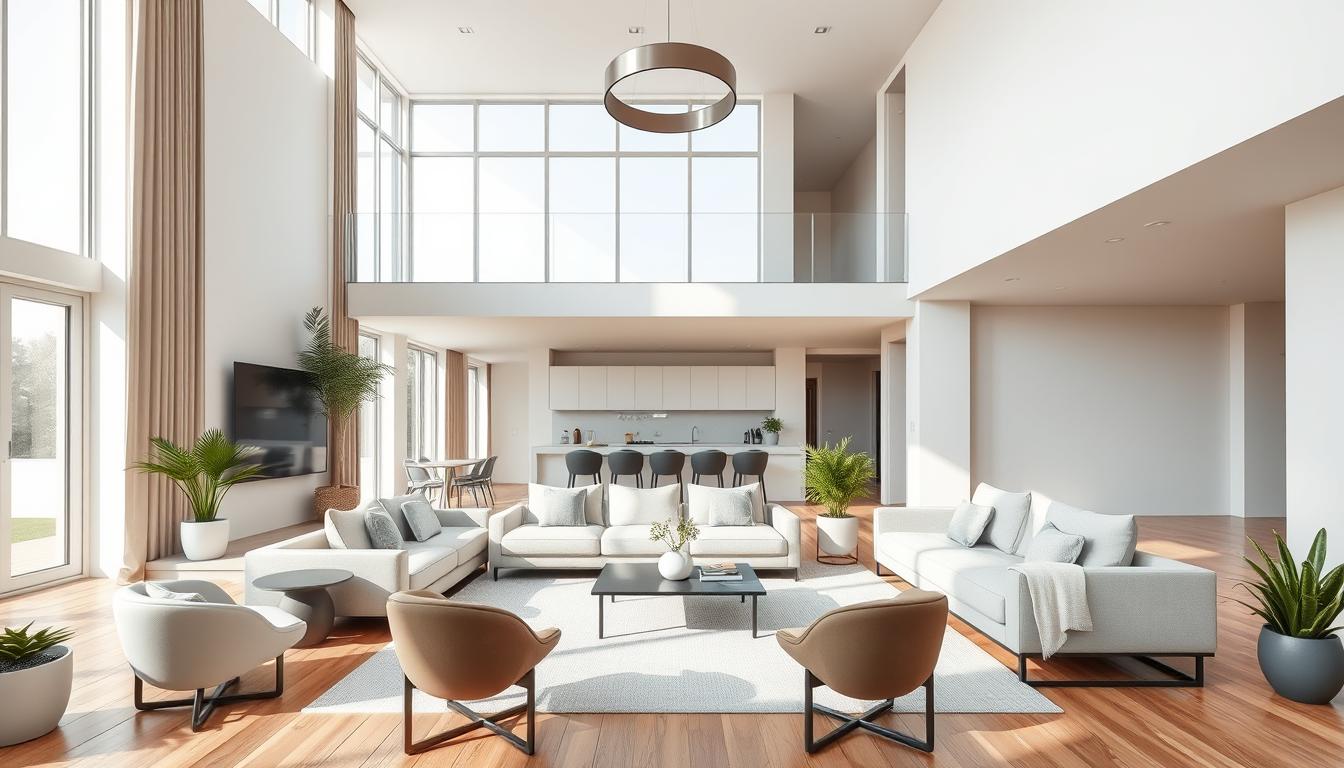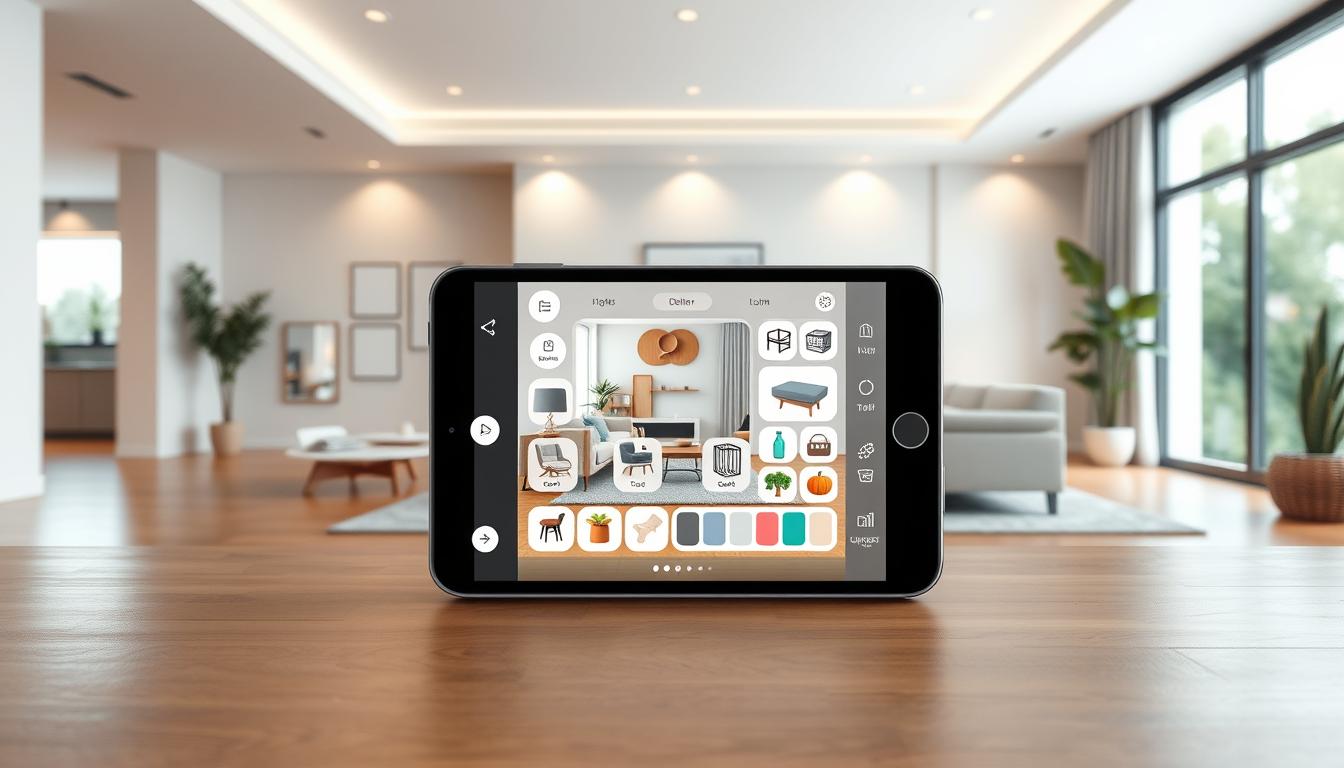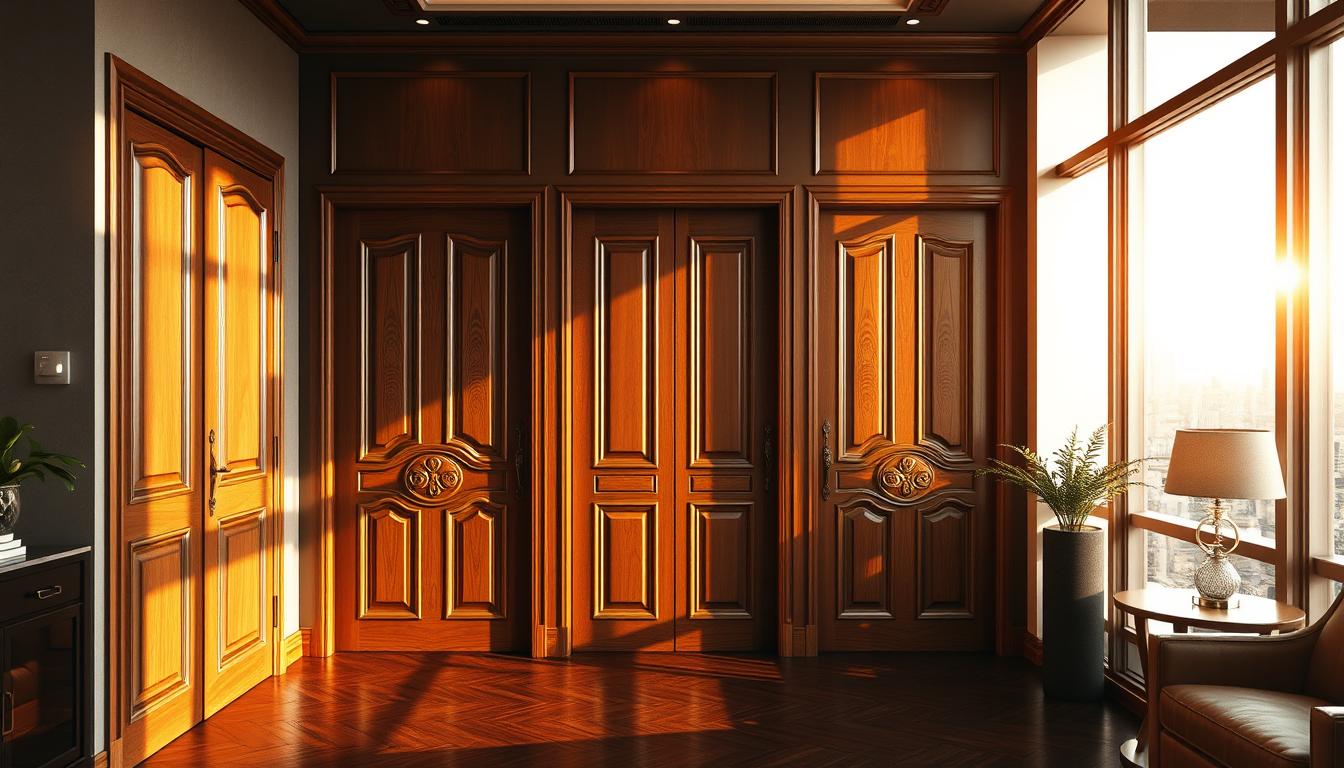Did you know a well-designed living space can make you happier and more productive? With the rise of modern interior design, it’s now easy to make a stylish and useful living area that shows who you are.
We’ll dive into the world of minimalist home design. We’ll give you tips and tricks to make your space better. You’ll learn about sleek lines and monochromatic colors. We’ll show you how to mix beauty with usefulness.
Key Takeaways
- Discover the latest trends in modern interior design
- Learn how to incorporate minimalist principles into your decor
- Find out how to balance style and functionality in your living space
- Get inspired by our top home interior decoration ideas
- Create a stylish and functional living area that reflects your personality
Embracing Minimalism in Home Decor
Minimalism in home decor is all about simplicity. It uses clean lines, simple shapes, and a few colors. This creates a calm and tidy living space.
Minimalist design is not just about looks. It’s also about being practical and easy to keep clean. By keeping only what’s essential, your home becomes more organized and peaceful.
Defining Minimalism
Minimalist home decor is simple, with clean lines and a few colors. It focuses on removing clutter and unnecessary items. Instead, it uses functional pieces that have a purpose.
Using negative space is key in minimalist design. Leaving some areas empty helps create calm and balance.
Benefits of Minimalist Design
Minimalist design makes your home easier to clean and maintain. With fewer things to dust and polish, upkeep is simpler.
It also reduces stress and improves mental clarity. A clutter-free home promotes calm and well-being.
| Benefits | Description |
|---|---|
| Easier Maintenance | Fewer surfaces and objects to clean |
| Reduced Stress | Clutter-free environment promotes calm |
| Improved Clarity | Simplified space enhances mental focus |
Tips for Achieving Minimalism
To get a minimalist look, start by decluttering. Remove items you don’t need and consider donating or recycling them.
Choose furniture that does more than one thing. For example, a storage ottoman can be a seat and a storage spot.
If you like DIY home decor, think about using old items. An old ladder can become a bookshelf, or an antique door can be a coffee table.
For affordable home decorating, look for sales or use what you already have. You can also use natural elements like branches or stones to add interest.
Incorporating Bold Colors into Your Space
Using bold colors can make your living space stylish and welcoming. These colors add depth, energy, and personality to your decor. They can also create a unique atmosphere that shows off your style.
Choosing the Right Palette
Choosing the right color palette is key when using bold colors. Think about the look you want and the mood you aim for. For inspiration, check out our top home color combination ideas for interior spaces.
Start by picking the bold color you want to use. Then, balance it with neutral colors to avoid too much. Use the 60-30-10 rule: 60% of a dominant color, 30% of a secondary color, and 10% of an accent color.
Accent Walls and Statement Pieces
Accent walls and statement pieces are great for adding bold colors. An accent wall can be a room’s focal point, drawing the eye. Pick a wall that naturally catches the eye, like the one behind a sofa or bed.
Statement pieces, like vibrant artwork or colorful furniture, also add bold touches. These elements not only add color but also make the room’s personality shine.
Color Psychology in Home Design
Understanding color psychology helps in designing your space. Colors can evoke emotions and change a room’s feel. Reds and oranges can make a room warm and lively, while blues and greens can bring calmness.
By picking bold colors based on their psychological effects, you can create a space that looks and feels great. Think about the room’s purpose and the mood you want to create when choosing colors.
Textures That Transform a Room
Adding different textures can make a room feel more welcoming. It’s a simple yet effective way to add depth and interest. By mixing materials, we can make a space stylish, comfortable, and inviting.
Utilizing Fabrics Wisely
Fabrics are key in interior design, offering a variety of textures. They can change a room’s feel, from soft velvet to rugged canvas. When picking fabrics, think about how they look and function, matching your lifestyle and the room’s purpose.
Durable fabrics like microfiber are great for busy areas or pet homes. Luxurious fabrics like silk add elegance to formal rooms. Mixing fabrics creates a layered, dimensional look that boosts the decor.
Layering with Rugs and Curtains
Rugs and curtains add texture and function to a room. A plush rug warms the floor, while curtains soften the windows. Layering them creates a cozy, inviting space.
Layer rugs with different textures, like a natural fiber under a plush one, for depth. Choose curtains that match the room’s textures, like linen or cotton, to enhance the look. This thoughtful layering changes the room’s feel, making it more welcoming.
Natural Materials for a Cozy Feel
Using natural materials warms and cozies a room. Wood, stone, and woven fibers add character and depth. They can be furniture, accents, or structural features, making the space organic and inviting.
A wooden coffee table or a stone fireplace can be a focal point. They add texture and authenticity. Embracing natural materials connects the room to the outdoors, enhancing comfort and relaxation.
Creative Furniture Layouts
A well-planned furniture layout is key to a harmonious and functional living space. It affects the room’s look and how it works. We’ll look at how to make a layout that’s both stylish and practical, using the space well.
Room Flow and Functionality
When planning your furniture layout, think about the room’s flow. You want a path that’s easy to walk and makes the space useful. For example, in a living room, arrange furniture in a circle for better conversation.
To get good flow, keep the main path clear of too much furniture. Make sure there’s enough room to move around comfortably. This smart planning is part of affordable home decorating and doesn’t need new furniture.
Using Furniture to Define Spaces
Furniture can mark off different areas in an open-plan space. A sofa can separate the living area from the dining space. This is a smart home interior decoration idea for making clear zones in a big area.
Using rugs, curtains, or different floors can also define spaces. These add texture and interest, making the area feel more lively and layered.
| Layout Strategy | Description | Benefits |
|---|---|---|
| Conversational Circle | Arrange furniture to facilitate conversation. | Encourages social interaction, creates a cozy atmosphere. |
| Floating Furniture | Place furniture away from walls to create a more intimate setting. | Makes the room feel larger, improves flow. |
| Zone Creation | Use furniture to define different areas within a room. | Enhances functionality, adds visual interest. |
Tips for Small Area Layouts
In small spaces, choose furniture that does more than one thing. For example, a storage ottoman can be a seat and a storage spot. This is a smart part of affordable home decorating, as it saves space and is practical.
Also, use mirrors wisely. They can make a room look bigger by reflecting light and images. This is a simple yet effective home interior decoration idea for small spaces.
The Impact of Lighting on Interiors
Lighting is key in interior design, setting the mood of a space. It can change a room’s feel, making it more welcoming or cozy. Good lighting boosts your home’s look and function.
Types of Lighting Fixtures
There are many lighting fixtures for different effects. Ambient lighting lights up the whole room. Task lighting helps with activities like reading. Accent lighting shines on special features.
Choosing the right lighting depends on the room’s purpose. A living room might need ambient and accent lighting. A kitchen needs bright task lighting.
Layering Light for Ambiance
Layering light creates a beautiful and useful lighting scheme. It mixes overhead, table, and floor lamps for a layered look. This method makes a room flexible and inviting.
Begin with ambient lighting as the base. Add task lighting where needed. Then, use accent lighting to highlight features or add interest.
Seasonal Lighting Adjustments
Changing your lighting with the seasons can change your home’s feel. Warmer lights make a space cozy in winter. Brighter lights refresh in summer.
Smart lighting systems let you change light colors and brightness with the seasons. This makes your home more lively and adaptable.
Sustainable Decor Options
Home decor is evolving, with sustainability playing a key role. It’s not just a trend; it’s essential for a stylish, eco-friendly home. As we become more aware of environmental issues, adding sustainable decor to our homes is crucial.
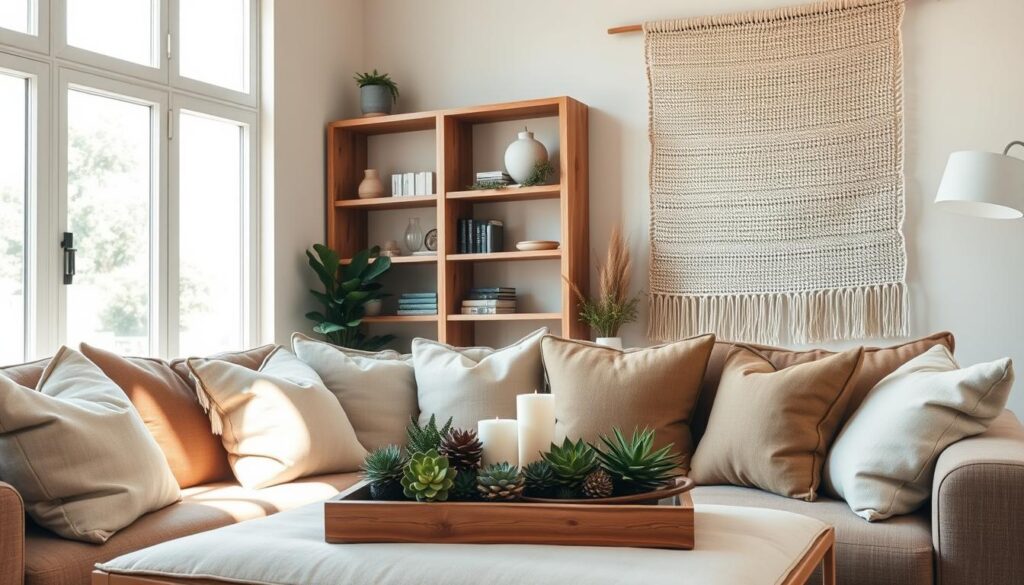
Eco-Friendly Materials
Choosing eco-friendly materials is a simple way to make our homes greener. Look for materials that are recycled, recyclable, or sustainably sourced. For example, using reclaimed wood furniture is stylish and helps save forests.
Bamboo is also a great choice because it grows quickly and is sustainable. For DIY projects, using eco-friendly materials can save money and be fun. Think about repurposing old items or using natural materials like reclaimed wood or bamboo.
Upcycling Ideas for Home Items
Upcycling breathes new life into old items, reducing waste and adding a personal touch. For instance, turning mason jars into pendant lights or wooden crates into coffee tables is eco-friendly and unique. With creativity, the options are endless, making home renovation affordable and sustainable.
- Turn old pallets into wall art or shelves.
- Use vintage windows as room dividers or decorative wall hangings.
- Transform old fabric into unique throw pillows or quilts.
Benefits of Choosing Sustainable Decor
Choosing sustainable decor benefits our homes and health. It improves indoor air quality by avoiding harmful chemicals. Plus, it can be stylish, allowing us to create a beautiful home that reflects our values. Sustainable decor is affordable, making it easy to decorate stylishly without spending a lot.
In conclusion, adding sustainable decor to our homes is a step towards a greener lifestyle. By picking eco-friendly materials, upcycling, and understanding sustainable decor’s benefits, we can make our homes beautiful and sustainable.
The Power of Artwork and Personal Touches
The right artwork can change a room, making it feel more welcoming. Artwork and personal touches are key in home decor. They let us show our personality and style.
Selecting Art that Resonates
Choosing artwork is important. Pick pieces that speak to you. This could be a painting that matches your favorite colors or a photo of a special moment. Artwork that holds personal significance makes your space feel real and meaningful.
Think about your style and your home’s look when picking art. For example, modern homes might look good with contemporary art. This art often has bold colors and shapes.
Gallery Walls and Focal Points
Gallery walls are great for showing off your favorite art and photos. Choose a theme or color scheme to keep it looking good. This ties everything together and makes it visually appealing.
Gallery walls can also be a creative home decor inspiration. Mixing frame styles and sizes makes it interesting and engaging. It adds a unique touch to any room.
Incorporating Personal Collections
Adding personal collections to your decor makes your space special. It could be vintage items, antique furniture, or sentimental trinkets. Displaying these items adds character and warmth.
Use decorative display cases or shelves to show off your favorites. This adds visual interest and shows off your home interior decoration ideas. It makes your space reflect your personality.
Smart Storage Solutions
Smart storage solutions are key to a stylish and functional living space. A clutter-free home looks great and makes life easier. It helps keep things organized and reduces stress.
Clever Use of Shelving
Shelving is great for both storing and decorating. Floating shelves are perfect for books, decorations, or kitchenware. They keep things within reach while keeping your space clean.
Adjustable shelving units are also useful. They can be customized to fit your storage needs. This is great for closets or home offices.
Multi-functional Furniture
Multi-functional furniture is a big help in small spaces. Items like storage ottomans or coffee tables with storage hide clutter. This keeps your living areas tidy.
A murphy bed is another great example. It folds up against the wall when not in use. This frees up floor space for other activities or storage.
Decluttering Strategies for a Neat Space
Decluttering is key to a neat home. Begin by sorting items into categories: keep, donate, sell, and discard. Be honest about letting go of items that don’t serve a purpose or bring joy.
For a more detailed plan, make a decluttering schedule. Set specific times for different areas or tasks. This makes the process easier to manage.
| Decluttering Task | Frequency | Tips |
|---|---|---|
| Sort through clothing | Seasonally | Consider the 1-year rule: if you haven’t worn it in a year, consider letting it go. |
| Organize paperwork | Monthly | Use a filing system to keep documents like bills, receipts, and contracts organized. |
| Clean out kitchen cabinets | Quarterly | Check expiration dates on food items and dispose of anything expired or unused. |
By using these smart storage solutions, you can have a more organized, clutter-free home. It will reflect your style and make daily life more efficient.
Bringing Nature Indoors
Bringing the outdoors in is a modern trend that makes our homes look better and feel better. It adds natural elements to our living spaces, making them more welcoming.
Houseplants for Every Room
Houseplants are a simple way to bring nature inside. They clean the air and add greenery to our decor. Some great plants for indoors are snake plants, spider plants, and peace lilies.
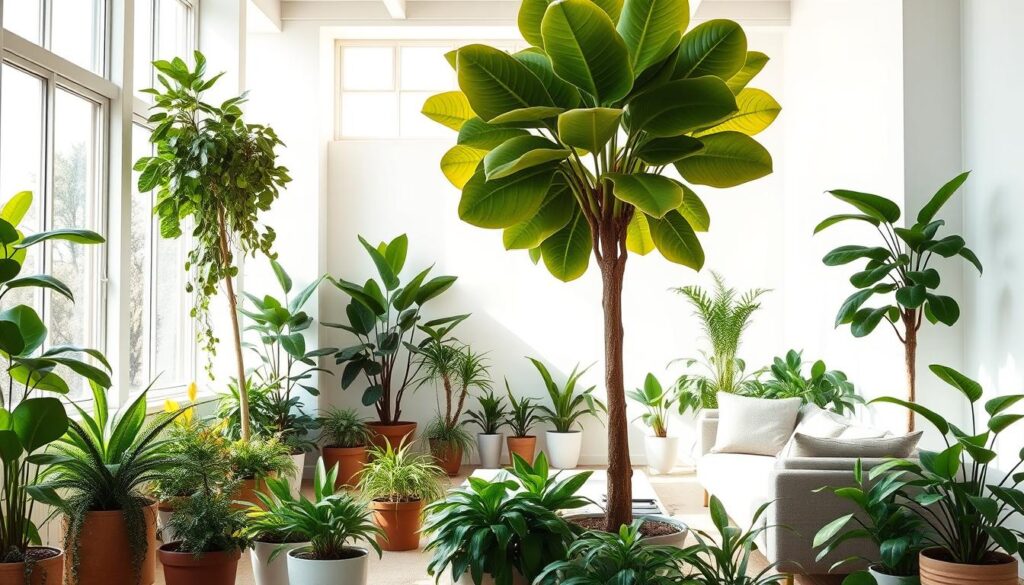
When picking houseplants, think about the light and care they need. For example, Chinese Evergreen does well in low light, while Succulents need lots of sun.
Creating a Biophilic Design
Biophilic design connects nature with our built environments. It uses natural materials and patterns to make our homes feel better.
“Biophilic design is not just about adding plants or natural materials; it’s about creating a holistic environment that nurtures our connection to nature.”
To make a biophilic design, use natural materials like wood and stone. Add elements like water features or living walls. You can use reclaimed wood for furniture or install a living wall.
| Element | Description | Benefits |
|---|---|---|
| Natural Materials | Wood, Stone, Plants | Aesthetic appeal, Sustainability |
| Water Features | Fountains, Aquariums | Calming effect, Visual interest |
| Living Walls | Vertical gardens | Air purification, Unique decor |
Tips for Indoor Gardening
Indoor gardening needs some planning and knowledge. Here are a few tips to start:
- Choose plants that are right for indoor spaces.
- Use containers with good drainage.
- Water plants regularly but not too much.
- Make sure plants get the right amount of light.
By following these tips and adding houseplants and biophilic design, we can make our homes more natural and welcoming. This improves our well-being and connects us to nature.
Modern vs. Traditional Styles
Knowing the difference between modern and traditional interior design is key. It helps you create a space that shows your style. These styles affect the feel and use of your home.
Key Characteristics
Modern style is all about simplicity and clean lines. It uses new materials and tech for a sleek look. Traditional style, on the other hand, is ornate with classic furniture and rich colors.
Here’s a table to show the differences:
| Feature | Modern Style | Traditional Style |
|---|---|---|
| Furniture | Sleek, minimalist designs | Ornate, classic pieces |
| Color Scheme | Neutral tones, bold accents | Rich, warm colors |
| Materials | New materials, glass, steel | Wood, velvet, silk |
Blending Styles
Mixing modern and traditional styles can make your space unique. The trick is to find a balance. For example, pair a modern sofa with a traditional armchair.
“The art of interior design lies in the ability to blend different styles seamlessly, creating a space that is both beautiful and functional.”
When mixing styles, pick a common thread like color or texture. This will tie your space together.
Tips for a Cohesive Design
To blend modern and traditional styles well, follow these tips:
- Start with a neutral base: Use a neutral color palette to provide a backdrop for your mixed-style furniture and decor.
- Choose a unifying element: Select a common thread, such as a specific material or texture, to tie different pieces together.
- Balance scale and proportion: Ensure that the scale of your furniture and decor is balanced to avoid overwhelming the space.
By understanding modern and traditional styles and how to mix them, you can make a stylish home that shows your taste.
Seasonal Decor Ideas
Seasonal decor changes can make your home feel welcoming and festive. By using elements that match the season, your space stays fresh and exciting all year.
Refreshing Your Space for Holidays
Holidays are a great time to update your home decor. Choose key elements like a Christmas tree or Halloween decorations. These help make your space feel cohesive and festive.
For Christmas, decorate your mantel with stockings, garlands, and festive figures. For Halloween, use orange and black decorations and spooky lighting for a haunting feel.
Seasonal Color Updates
Changing your color palette with the seasons keeps your decor fresh. In spring, use pastel colors and fresh greens. Summer is perfect for bright, bold colors like coral and turquoise.
Autumn brings warm tones like orange, red, and yellow for a cozy feel. Winter is for blues and silvers, creating calm and serenity. Use these colors in throw pillows, blankets, and wall decor.
Decorating with Nature
Adding natural elements is a great way to decorate for the seasons. In spring, fresh flowers or branches add greenery. Summer is great for seashells, driftwood, or beach finds.
Autumn is for leaves, pinecones, and acorns for an earthy feel. Winter decor includes evergreen branches, holly, or mistletoe. These elements add interest and connect your home to nature, offering creative home decor inspiration.
Using these seasonal decor ideas keeps your home fresh and festive without spending a lot. It’s a smart way to affordable home decorating.
Working with Small Spaces
Maximizing a small space needs careful planning. It’s about finding a balance between function and style. With a few smart design choices, you can make your home both stylish and practical.
Vertical Space Utilization
To use your space well, think about going up. Floor-to-ceiling shelves or storage units can keep things tidy. They also make your space look bigger by pulling your eye up.
This idea fits well with minimalist home design. It helps keep your space clean and simple.
Effective Space-Saving Hacks
In small homes, it’s smart to choose stylish home accessories that do more than one thing. Look for furniture like ottomans with storage or wall-mounted desks. These home renovation tips help you arrange your space more efficiently.
Multi-Functional Decor
Decor that’s both useful and stylish is essential in small spaces. For example, a storage coffee table or a decorative basket can be both pretty and practical. By picking each piece carefully, you can make your home welcoming and well-organized.

